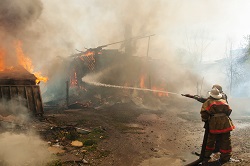Putting out fires with new, state-of-the-art water jet
The world’s growing population means bigger cities, bigger buildings and a bigger risk of fire. Although today’s buildings come with modern requirements and state-of-the-art fire safety equipment, many of the buildings – and especially skyscrapers – built in the 1970s and 1980s lack the necessary fire-extinguishing equipment. The EU-funded JET ANTI-FIRE project set out to change that The JET ANTI-FIRE system was developed to extinguish a fire in half the time it takes when using conventional equipment – using half the required energy and water and at a fraction of the price. ‘When fire breaks out in a building, time is of the essence,’ explains the project’s technical expert Fabio Bosetti. ‘Being able to extinguish a fire quicker means not only saving lives, but also saving property and thus preserving business continuity.’ According to Bosetti, JET ANTI-FIRE answers a very specific need. It all started during the preparations for EXPO 2015 in Milan. The many new skyscrapers that were built for the EXPO had to satisfy national security standards. ‘What we found was that none of the equipment available at that time met these stringent standards,’ adds Bosetti. ‘In this sense, JET ANTI-FIRE is not an evolution of an existing product, but an entirely new concept that does not have an equivalent.’ A constant stream of water Extinguishing fires faster means giving firefighters access to a constant and sufficient stream of water released at the right pressure. To achieve this, the JET ANTI-FIRE system uses two specific components: a hydrant tap and a water jet system. The hydrant tap makes sure the water pressure is constant and balanced, while the jet system fractures and pulverises water into small particles. This creates a fog that breaks down the firefighters’ surrounding temperature, enabling them to more effectively target and combat the fire. Big benefits The result is a 50 % increase in fire extinguishing efficiency, which also doubles the protection of all the civilians and structures involved. What’s more, the system consumes half the amount of water used by conventional fire-extinguishing equipment. ‘Think of how much less space will be needed to allocate water reserves in historic city centres, or of the possibility to build fire-fighting facilities in areas with water scarcity that would otherwise be impossible,’ adds Bosetti. The fact that JET ANTI-FIRE uses low water pressure is a major benefit for the safety of the firefighters, as they can use and control the system themselves. It also enables the system to be connected to municipal water networks without the addition of electric pumps – another money saving feature. The project’s next steps are to make the necessary adjustments so the system satisfies the fire regulations of other countries.



